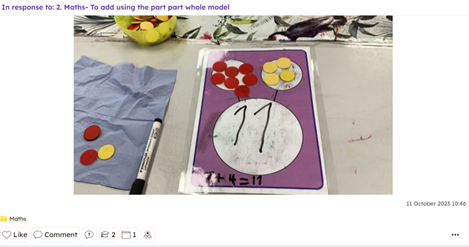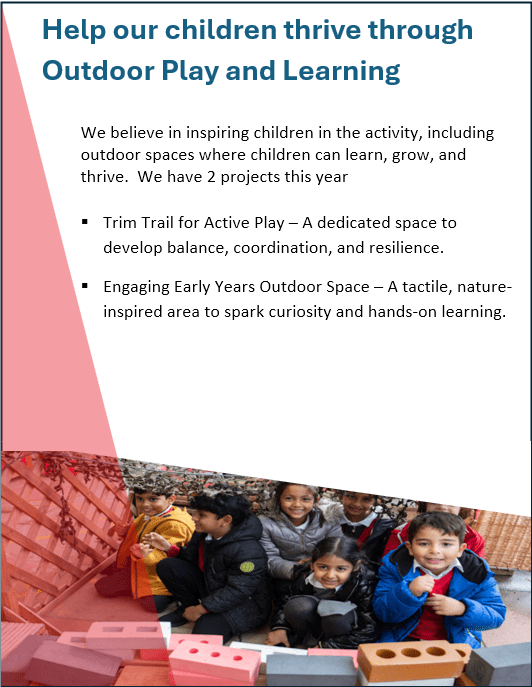What environment do we offer?
An infant build that offers an enriched continuous provision approach from Early Years to Year 1. The approach identifies a clear progression from EYFS pedagogy, enabling children to be independent, active and engaged in their learning combined with a personalised approach to meet the National Curriculum objectives for Year 1. Children are independent in their learning approach and challenge themselves because they love learning.
At Kestrel Mead we believe that children learn best through play based and active learning that develops their curiosity and independence.
Our staff understand the importance of developing and extending the children’s toolkit to learn and allowing them the opportunities to apply these skills independently and in different ways.
Our EYFS and Year 1 environment is set up as 2 bases with areas shared between each classroom. The learning areas in each year group have been thought out carefully to match the skill development for each age range in relation to the EYFS and KS1 curriculum. EYFS and Year 1 also offers a continuation of the classroom in the form of an outdoor learning space. .
Why should we continue Continuous Provision in Year 1?
- Young children up to at least age 7 are still motivated and engaged to learn by their own interests and when it is initiated by themselves.
- Many Year 1 children are not ready for learning that requires them to sit down for long periods of time.
- Creativity, curiosity, critical thinking, problem solving and teamwork opportunities. Opportunities to make mistakes.
- Time for adults to work 1:1 or small groups and have more focus time per child as well as engaging with them within continuous provision.
- Meaning, Memory and Connections – Children need to have a meaning for their learning. Why do I need to learn this? If they are choosing the learning for themselves, it becomes more purposeful and relevant to them. Memory – exploring opportunities and revisiting using resources, building on their learning and problem solving allows for learning to be moved to their long-term memory. Making connections – is like a jigsaw puzzle, often children have lots of bits of information but need more time to apply them and figure out how things fit together to connect their learning for themselves.
How do we ensure continuous provision is challenging and purposeful?
“…we are aware of the sort of learning that our areas of provision promote and also how we are targeting specific skill development within those spaces.”
“…open ended experiences in CP allow them to discover, experiment and explore…”
“…a planning system that promotes high level attainment by capitalising on children’s high-level engagement.”
Continuous Provision, The Skills, Alistair Bryce Clegg
At Kestrel Mead, our Sticky Curriculum is planned to support children in learning knowledge and skills in a memorable way. The continuous provision supports children to be able to commit this learning to their long-term memory as they have had opportunities to reflect.
Enhancements are planned alongside our Sticky Curriculum, English, Maths, Science and RE learning. They provide additional opportunities for children to develop their skills. They are planned where natural links occur in order to enhance the learning taking place and allow children to reflect on this throughout the week.
Mr Stretch is applied to the challenges to add breadth and depth to challenge pupils throughout different subjects and challenges. Teachers can use this opportunity for AfL to direct pupils to further their learning and deepen their knowledge throughout.
In Year 1 children record their learning in Continuous provision independently using seesaw, teachers are then able to review and respond to this appropriately. Each post links to the national curriculum objective and is assessed against this.
Here is an example:

![]()
Star rating for each piece will be used as part of our assessment system.
* Objective not met – support needed here or differentiation to break down the learning
** Objective working towards being met – close
*** Objective met
****Objective met above expectations
Based on the gap strength analysis in EYFS and observation in KS1, the provision should reflect the needs of the children. As a school we have identified that the areas you may see in the classrooms to support children in their development are listed below. This may mean that each classroom or provision will look different within each year group.
| EYFS:
Indoor: |
EYFS:
Outdoor: |
Year 1:
Indoor: |
Year 1:
Outdoor: |
|
|
|
|
Within provision it would be expected for English and Maths to be applied across all other areas of learning. Resources therefore are made available throughout the classroom to support children’s development with these skills.


 Be The Best That You Can Be
Be The Best That You Can Be